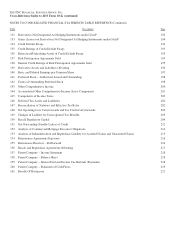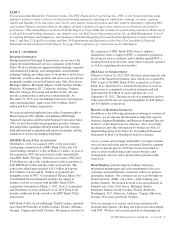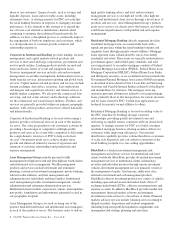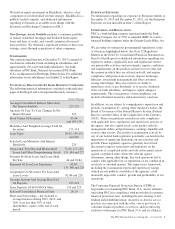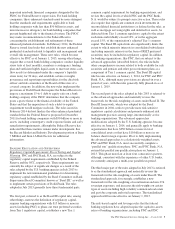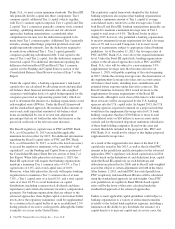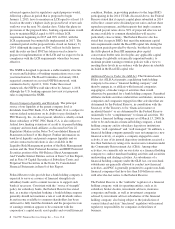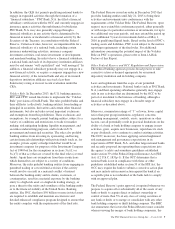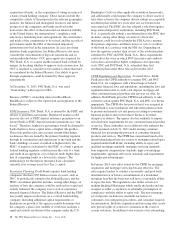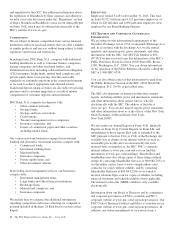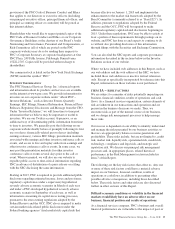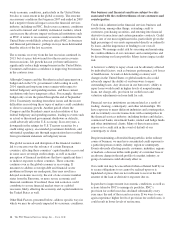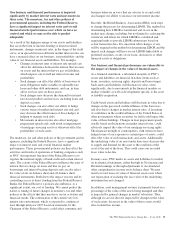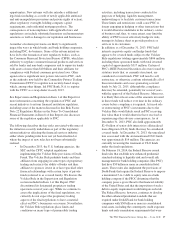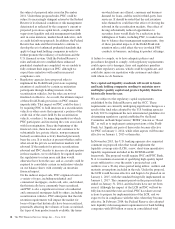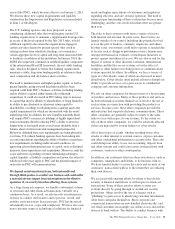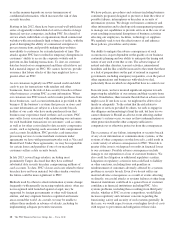PNC Bank 2013 Annual Report Download - page 28
Download and view the complete annual report
Please find page 28 of the 2013 PNC Bank annual report below. You can navigate through the pages in the report by either clicking on the pages listed below, or by using the keyword search tool below to find specific information within the annual report.
acquisition of banks, or the acquisition of voting securities of
a bank or bank holding company. These factors include the
competitive effects of the proposal in the relevant geographic
markets; the financial and managerial resources and future
prospects of the companies and banks involved in the
transaction; the effect of the transaction on financial stability
of the United States; the organizations’ compliance with
anti-money laundering laws and regulations; the convenience
and needs of the communities to be served; and the records of
performance under the CRA of the insured depository
institutions involved in the transaction. In cases involving
interstate bank acquisitions, the Federal Reserve also must
consider the concentration of deposits nationwide and in
certain individual states. OCC prior approval is required for
PNC Bank, N.A. to acquire another insured bank or thrift by
merger. In deciding whether to approve such a transaction, the
OCC is required to consider factors similar to those that must
be considered by the Federal Reserve. Our ability to grow
through acquisitions could be limited by these approval
requirements.
At December 31, 2013, PNC Bank, N.A. was rated
“Outstanding” with respect to CRA.
Because of PNC’s ownership interest in BlackRock,
BlackRock is subject to the supervision and regulation of the
Federal Reserve.
FDIC Insurance. PNC Bank, N.A. is insured by the FDIC and
subject to premium assessments. Regulatory matters could
increase the cost of FDIC deposit insurance premiums to an
insured bank as FDIC deposit insurance premiums are “risk
based.” Therefore, higher fee percentages would be charged to
banks that have lower capital ratios or higher risk profiles.
These risk profiles take into account, among other things,
weaknesses that are found by the primary banking regulator
through its examination and supervision of the bank and the
bank’s holdings of assets classified as higher risk by the
FDIC. A negative evaluation by the FDIC or a bank’s primary
federal banking regulator could increase the costs to a bank
and result in an aggregate cost of deposit funds higher than
that of competing banks in a lower risk category. The
methodology for the deposit insurance base calculation
currently uses average assets less Tier 1 capital.
Resolution Planning. Dodd-Frank requires bank holding
companies that have $50 billion or more in assets, such as
PNC, to periodically submit to the Federal Reserve and the
FDIC a resolution plan that includes, among other things, an
analysis of how the company could be resolved in a rapid and
orderly fashion if the company were to fail or experience
material financial distress. The Federal Reserve and the FDIC
may jointly impose restrictions on a covered bank holding
company, including additional capital requirements or
limitations on growth, if the agencies jointly determine that
the company’s plan is not credible or would not facilitate a
rapid and orderly resolution of the company under the U.S.
Bankruptcy Code (or other applicable resolution framework),
and additionally could require the company to divest assets or
take other actions if the company did not submit an acceptable
resolution plan within two years after any such restrictions
were imposed. The FDIC also has adopted a rule that requires
large insured depository institutions, including PNC Bank,
N.A., to periodically submit a resolution plan to the FDIC that
includes, among other things, an analysis of how the
institution could be resolved under the FDI Act in a manner
that protects depositors and limits losses or costs to creditors
of the bank in accordance with the FDI Act. Depending on
how the agencies conduct their review of the resolution plans
submitted by PNC and PNC Bank, N.A., these requirements
could affect the ways in which PNC structures and conducts
its business and result in higher compliance and operating
costs. PNC and PNC Bank, N.A. submitted their first
resolution plans under these rules in December 2013.
CFPB Regulation and Supervision. As noted above, Dodd-
Frank gives the CFPB authority to examine PNC and PNC
Bank, N.A. for compliance with a broad range of federal
consumer financial laws and regulations, including the laws and
regulations that relate to credit card, deposit, mortgage and
other consumer financial products and services we offer. In
addition, Dodd-Frank gives the CFPB broad authority to take
corrective action against PNC Bank, N.A. and PNC as it deems
appropriate. The CFPB also has powers that it was assigned in
Dodd-Frank to issue regulations and take enforcement actions
to prevent and remedy acts and practices relating to consumer
financial products and services that it deems to be unfair,
deceptive or abusive. The agency also has authority to impose
new disclosure requirements for any consumer financial product
or service. These authorities are in addition to the authority the
CFPB assumed on July 21, 2011 under existing consumer
financial law governing the provision of consumer financial
products and services. The CFPB has concentrated much of its
initial rulemaking efforts on a variety of mortgage related topics
required under Dodd-Frank, including ability-to-repay and
qualified mortgage standards, mortgage servicing standards,
loan originator compensation standards, high-cost mortgage
requirements, appraisal and escrow standards and requirements
for higher-priced mortgages.
In January 2014, new rules issued by the CFPB for mortgage
origination and mortgage servicing became effective. The
rules require lenders to conduct a reasonable and good faith
determination at or before consummation of a residential
mortgage loan that the borrower will have a reasonable ability
to repay the loan. The regulations also define criteria for
making Qualified Mortgages which entitle the lender and any
assignee to either a conclusive or rebuttable presumption of
compliance with the ability to repay rule. The new mortgage
servicing rules include new standards for notices to
consumers, loss mitigation procedures, and consumer requests
for information. Both the origination and servicing rules create
new private rights of action for consumers in the event of
certain violations. In addition to the exercise of its rulemaking
10 The PNC Financial Services Group, Inc. – Form 10-K


